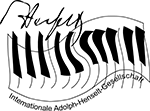“And he has arrived, a peerless man with his heart and head in the right place, Adolph Henselt, and I agree with the Davidsbündlerin Sara who ranks him; he who has yet been little heard; he who barely has opus 1 behind him, amongst the best of the young artistic corps. You know, Florestan, we have studied a lot together at the piano, indulging in finger exercises and Beethoven, to achieve the best tone. But what I call mellow tone, tonal magic has not yet been revealed to me in a higher degree than in Henselt’s compositions”
– Robert Schumann –
Characteristic of Henselts music:
The characteristic features of Henselt’s compositions, <mellow sound> and <tonal magic,> which so extraordinarily impressed his contemporaries, essentially resulted from his precise knowledge of the piano as an instrument and its tonal resources as well as from his special training in playing technique involving, in particular, systematic stretching exercises for the hands. Henselt preferred chords of extreme width and in this preference fully exploited the piano resonance richness in the middle range with all the artistic resources of part distribution with concise melodic design or enhanced it with discreet secondary <melodic events> such as counterparts, passing notes, or transitional phrases. Broad chordal playing figures, the rich contouring of cantilenas with parallel leading in thirds, sixths, or tenths, chord chains, and accompaniment parts with deliberately uneven striking also contributed to the fullness of sound in Henselt’s music. The invention of concise melody is essentially marked by diatonicism or progression in triadic diastematic design, with Henselt employing chromaticism and broad intervals as means of emphasis with economy and thus making them all the more effective as far as their expressive power is concerned.
The composer Henselt’s extraordinary interest in <working on piano sound> without a doubt pushed the development of complex forms and the employment of instrumentations of various kinds into the background. Compositions of larger or even cyclical design or those going beyond piano solo performance are thus correspondingly rare in his oeuvre. Apart from the magnificent Piano Concerto in F minor op. 16 and two cycles of variations (op. 1 and op. 13), the second of which had an orchestral accompaniment, the Duo for piano and violoncello or violin and horn op. 14 and the Trio for piano, violin, and violoncello op. 24 represent all that he bequeathed to posterity in this respect. Three compositions from this group have been recorded here: the Variations de Concert op. 1, the horn version of the Duo, certainly the tonally most fascinating of its three versions, and the Trio. The idea of the poetic piano piece, very much along the lines of the new musical romantics who began forming as a group in the 1830s, dominates in Henselt’s other original works. Although the titles of his piano pieces do not indicate it, the combination of <melomania> and keyboard virtuosity so specifically characteristic of Henselt essentially manifests itself in the form of the <sond without words.> A clearly structured melos is sung out to the last; it is imbedded in the broad, sonorous piano part, accompanied by figure work in fascinating style, and <illuminated> impressively by a harmony rich in color. The formal design remains easy to grasp, and structuring elements such as preludes, interludes, and postludes often point to song with instrumental accompaniment as his model.
Examples:
Daniel Grimwood: Four Etudes
Op. 5 No. 4, E major – “Ave Maria”, Andante
Op. 2 No. 10, E minor – “Le Ruisseau”, Moderato (2:32)
Op. 5 No. 10, F minor – “Entschwundenes Glück”, Allegro ma non troppo (4:30)
Op. 2 No. 12, B flat minor, “Plien de soupirs, de souvenirs…”, Moderato ma con moto, con afflizione (9:08)
Natalia Keil-Senserowa: Romance op. 10
Natalia Keil-Senserowa: La Gondola, Etude op. 13 No. 2
Daniel Grimwood, Nazrin Rashidova und Sarah Oliver: Trio op. 24



